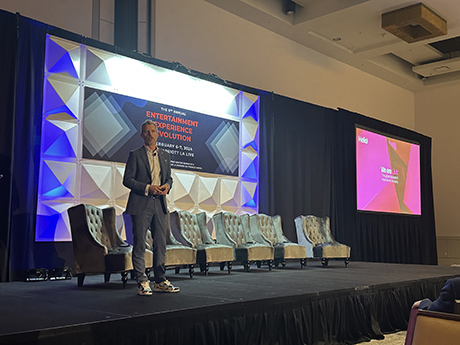Brick-and-mortar spaces aren’t the only areas where consumers exist nowadays. There’s the omnichannel approach that includes online shopping, yes, but today’s forward-thinking landlords and tenants know that the digital sphere is the next great conquest. This was one of the primary arguments made at InterFace Conference Group’s Entertainment Evolution Experience (EEE), which was held at the J.W. Marriott at L.A. Live in Downtown Los Angeles on February 6 and 7.
“Consumers are back and looking for experiences, but it really has to mean something to leave the sofa and comfort of Netflix and go into a shopping center,” said Benjamin Calleja, founder and chief experience officer for Livit Design, as well as the conference keynote speaker. “Digital is blurring the lines between the physical and virtual worlds, creating more ways to transform spaces.”
One only needs to look as far as the latest entertainment concepts to see how digital is playing an integral entertainment role in today’s shopping centers. Concepts like Dreamflyer, a virtual-reality (VR) flight simulator, and the immersive Elvis Evolution that includes a “concert” from the King himself illustrate how digital displays can merge with sensory experiences to create a new entertainment opportunity.
Travis Cloyd, CEO of Worldwide XR and senior fellow at the Thunderbird School of Global Management, noted that the pervasiveness of technology, digitalization and artificial intelligence (AI) has us living on the cusp of a major transition.
“How we explore content is massively shifting,” said the “Everything We Know About the Future of Entertainment is Wrong” panelist. “This is the beginning of the fifth industrial revolution, really.”
The adoption of digitalization varies today. For some concepts, such as Elvis Evolution, the digital space is everything. For others, such as Puttshack mini golf, the feature is less pronounced, yet still omnipresent.
“The minicomputer within each golf ball tracks where your ball goes, who you’re playing with, how many strikes you take and more,” said David Diamond, president of Puttshack and a panelist on the “Social Entertainment is Driving a Broader Market Appeal” session. “This means there’s no paper or pencil, so the guest can be totally immersed in the game.”
Doug Schnell, vice president of real estate for Level 99 and a participant in the “Site Selection for New Location-Based Entertainment Experiences” panel, believed it was this sort of balance – where the digital space exists behind the scenes but is not crucial to the physical product – that best balanced the two worlds.
“Technology should be an enabler, but is not the experience itself,” he said. “The experience should be tactile and physical in nature, allowing for social interaction to take place.”
Alexander Patterson, founder and CEO of Beat the Bomb, felt similarly. The Social Entertainment panelist noted that, for the most part, his concept’s physical space remained the same. What could change, however, were the types of games and digital content loaded into the server. This, Patterson said, would allow his concept to constantly evolve to meet market needs with little to know changes placed on the physical space.
“We can keep the same physical footprint because we can load new digital content into our servers,” he said. “As times change, we can create new games, future-proofing our concepts and amassing reasons for consumers to come back for more.”
— Nellie Day


